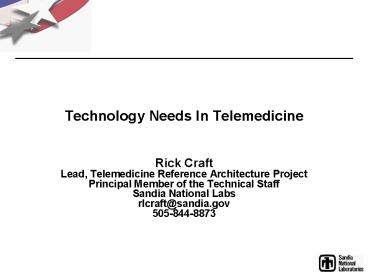Technology Needs In Telemedicine - PowerPoint PPT Presentation
1 / 11
Title:
Technology Needs In Telemedicine
Description:
Technology Needs In Telemedicine Rick Craft Lead, Telemedicine Reference Architecture Project Principal Member of the Technical Staff Sandia National Labs – PowerPoint PPT presentation
Number of Views:176
Avg rating:3.0/5.0
Title: Technology Needs In Telemedicine
1
Technology Needs In Telemedicine
- Rick Craft
- Lead, Telemedicine Reference Architecture Project
- Principal Member of the Technical Staff
- Sandia National Labs
- rlcraft_at_sandia.gov
- 505-844-8873
2
Telemedicines Past and Immediate Future
First Wave
Second Wave
Third Wave
Early 90s to present
Coming decade
Timeframe
60s-70s
Clinical Development
Emphasis
Feasibility
Industrialization
Fringe populations
Mainstream Care Delivery
Scope
Very limited
Nature
Video links
Instrumentation
Informatics
Telemedicine is still young and evolving.
Maturing it fully will require vision and
deliberate attention to the technical foundations
on which it rests.
3
Telemedicine Is About More Than Distance
4
Telemedicine Technology State of Affairs
- Systems are too expensive to enable wide-spread
diffusion - Systems from independent vendors do not
interoperate - What can be done over the wire falls far short
of what can be done in face-to-face encounters - Most systems are sold as turnkey capabilities
that are not easily customized to meet end
user-specific needs - Reliance on COTS devices designed for traditional
clinical environments limits range of settings in
which systems can be used
This Way To Anywhere, Anytime
Ubiquity
Capability
Affordability
5
Key Telemedicine Technology Needs
A New Generation Of Devices
Mechanisms for Knowledge Diffusion
Interoperability
- Less expensive
- Usable in more places by broader range of people
- Rich set of clinical capabilities
- Integration with EHRs
- Vendor neutral station-to-station
- Plug-and-play devices
- Dynamic federation of distributed components
- Self-configuring
- Self-calibrating
- Education and training for non-traditional actors
- Tech-embedded, process-specific decision aides
- Intelligent devices
- Standardized user interfaces to allow portability
of skills
6
Improving Healthcare Delivery Is A Systems Problem
- Healthcare systems are complex
- Their performance (cost, access, outcomes, etc.)
is affected by many factors - Delivery system organization
- Business and clinical processes
- External policies and financing
- Geography and demography
- Technology
- Small perturbations can yield big changes
- Finding the good ones and avoiding the bad can be
challenging
7
It Must Involve Both Optimization And
Transformation
This sentiment is echoed in the recent IOM/NAE
report on the role of engineering in healthcare
8
Optimization Approaches Have Their Limits
Fords Woodhaven Stamping Plant Performance
Status Assessment
Using Up Slack Among Independent Variables
A
B
Safety
Training
Hit-to-Hit
a
b
Productivity/Yield
Ergonomics
Inventory Reduction
d
c
Total Product MNT
Total Overhead
Organizational Dev.
Material Utilization
D
C
Quality Systems
0
1
2
3
4
5
6
7
8
9
10
Initial Condition 0 World Class Performance
10 1st Survey (4/90)
2nd Survey (11/91)
From Systems Thinking by Jamshid Gharajedaghi
9
Why Is This Important?
Age Distribution of the US Population
Age groups where care burden is greatest
Big problems at this level !!
Source 2000 US Census
50,000,000
45,000,000
Current workforce shortages pose difficulty with
care burden at this level
40,000,000
35,000,000
Population shift will increase care burden
30,000,000
Population
25,000,000
20,000,000
15,000,000
- We have four choices
- Reduce demand
- Raise premiums / taxes
- Limit benefits
- Extract more value
10,000,000
5,000,000
0
5 to 14
under 5
15 to 24
25 to 34
35 to 44
45 to 54
55 to 64
65 to 74
75 to 84
85 and over
Age (in deciles)
Courtesy of Kaiser Research and HealthTech
10
The National Healthcare Delivery Sciences Program
- Mission
- Identify high-payoff care delivery concepts
- Develop resources needed to implement these
concepts - Promulgate supporting policies
Vision A science of healthcare delivery as
advanced as our science of medicine
11
Final Thoughts
- The medical establishment is not currently
equipped to address this final problem - A partnership between medicine, engineering, law,
business, economics, social sciences, and other
disciplines is required - No entity currently owns the problem
- Not NIH, NSF, DoD, DOE, nor any private concerns
- This work could be birthed at the local level
and then raised at the national - Workshops / pilot initiatives would help provide
insights needed to engender a national dialog - If successfully cultivated, healthcare delivery
science will necessarily drive industry

